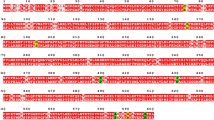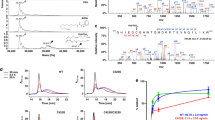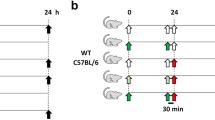Abstract
Selective inhibitors of cyclooxygenase-2 (COX2) have attracted widespread media attention because of evidence of an elevated risk of cardiovascular complications in placebo-controlled trials, resulting in the market withdrawal of some members of this class1,2,3,4,5. These drugs block the cyclooxygenase activity of prostaglandin H synthase-2 (PGHS2), but do not affect the associated peroxidase function. They were developed with the rationale of conserving the anti-inflammatory and analgesic actions of traditional nonsteroidal anti-inflammatory drugs (tNSAIDs) while sparing the ability of PGHS1-derived prostaglandins to afford gastric cytoprotection1,2,6. PGHS1 and PGHS2 coexist in the vasculature and in macrophages, and are upregulated together in inflammatory tissues such as rheumatoid synovia7 and atherosclerotic plaque8. They are each believed to function as homodimers6. Here, we developed a new genetic mouse model of selective COX2 inhibition using a gene-targeted point mutation, resulting in a Y385F substitution. Structural modeling and biochemical assays showed the ability of PGHS1 and PGHS2 to heterodimerize and form prostaglandins. The heterodimerization of PGHS1-PGHS2 may explain how the ductus arteriosus closes normally at birth in mice expressing PGHS2 Y385F, but not in PGHS2-null mice9,10.
This is a preview of subscription content, access via your institution
Access options
Subscribe to this journal
Receive 12 print issues and online access
$209.00 per year
only $17.42 per issue
Buy this article
- Purchase on Springer Link
- Instant access to full article PDF
Prices may be subject to local taxes which are calculated during checkout



Similar content being viewed by others
References
FitzGerald, G.A. Coxibs and cardiovascular disease. N. Engl. J. Med. 351, 1709–1711 (2004).
Grosser, T., Fries, S. & FitzGerald, G.A. Biological basis for the cardiovascular consequences of COX-2 inhibition: therapeutic challenges and opportunities. J. Clin. Invest. 116, 4–15 (2006).
Bresalier, R.S. et al. Adenomatous Polyp Prevention on Vioxx (APPROVe) Trial Investigators. Cardiovascular events associated with rofecoxib in a colorectal adenoma chemoprevention trial. N. Engl. J. Med. 352, 1092–1102 (2005).
Solomon, S.D. et al. Adenoma Prevention with Celecoxib (APC) Study Investigators. Cardiovascular risk associated with celecoxib in a clinical trial for colorectal adenoma prevention. N. Engl. J. Med. 352, 1071–1080 (2005).
Nussmeier, N.A. et al. Complications of the COX-2 inhibitors parecoxib and valdecoxib after cardiac surgery. N. Engl. J. Med. 352, 1081–1091 (2005).
Smith, W.L., DeWitt, D.L. & Garavito, R.M. Cyclooxygenases: structural, cellular, and molecular biology. Annu. Rev. Biochem. 69, 145–182 (2000).
Crofford, L.J. et al. Cyclooxygenase-1 and -2 expression in rheumatoid synovial tissues. Effects of interleukin-1 β, phorbol ester, and corticosteroids. J. Clin. Invest. 93, 1095–1101 (1994).
Schonbeck, U., Sukhova, G.K., Graber, P., Coulter, S. & Libby, P. Augmented expression of cyclooxygenase-2 in human atherosclerotic lesions. Am. J. Pathol. 155, 1281–1291 (1999).
Loftin, C.D. et al. Failure of ductus arteriosus closure and remodeling in neonatal mice deficient in cyclooxygenase-1 and cyclooxygenase-2. Proc. Natl. Acad. Sci. USA 98, 1059–1064 (2001).
Loftin, C.D., Trivedi, D.B. & Langenbach, R. Cyclooxygenase-1-selective inhibition prolongs gestation in mice without adverse effects on the ductus arteriosus. J. Clin. Invest. 110, 549–557 (2002).
Picot, D., Loll, P.J. & Garavito, R.M. The X-ray crystal structure of the membrane protein prostaglandin H2 synthase-1. Nature 367, 243–249 (1994).
Kurumbail, R.G. et al. Structural basis for selective inhibition of cyclooxygenase-2 by anti-inflammatory agents. Nature 384, 644–648 (1996).
Malkowski, M.G., Ginell, S.L., Smith, W.L. & Garavito, R.M. The productive conformation of arachidonic acid bound to prostaglandin synthase. Science 289, 1933–1937 (2000).
Morham, S.G. et al. Prostaglandin synthase 2 gene disruption causes severe renal pathology in the mouse. Cell 83, 473–482 (1995).
Dinchuk, J.E. et al. Renal abnormalities and an altered inflammatory response in mice lacking cyclooxygenase II. Nature 378, 406–409 (1995).
Lim, H. et al. Multiple female reproductive failures in cyclooxygenase 2-deficient mice. Cell 91, 197–208 (1997).
Shimokawa, T., Kulmacz, R.J., DeWitt, D.L. & Smith, W.L. Tyrosine 385 of prostaglandin endoperoxide synthase is required for cyclooxygenase catalysis. J. Biol. Chem. 265, 20073–20076 (1990).
Yu, Y. et al. Differential impact of prostaglandin H synthase 1 knockdown on platelets and parturition. J. Clin. Invest. 115, 986–995 (2005).
Nguyen, M. et al. The prostaglandin receptor EP4 triggers remodelling of the cardiovascular system at birth. Nature 390, 78–81 (1997).
Segi, E. et al. Patent ductus arteriosus and neonatal death in prostaglandin receptor EP4-deficient mice. Biochem. Biophys. Res. Commun. 246, 7–12 (1998).
Smith, G.C. The pharmacology of the ductus arteriosus. Pharmacol. Rev. 50, 35–58 (1998).
Yuan, C., Rieke, C.J., Rimon, G., Wingerd, B.A. & Smith, W.L. Partnering between monomers of cyclooxygenase-2 homodimers. Proc. Natl. Acad. Sci. USA 103, 6142–6147 (2006).
Trifan, O.C., Smith, R.M., Thompson, B.D. & Hla, T. Overexpression of cyclooxygenase-2 induces cell cycle arrest. Evidence for a prostaglandin-independent mechanism. J. Biol. Chem. 274, 34141–34147 (1999).
Funk, C.D., Funk, L.B., Kennedy, M., Pong, A. & FitzGerald, G.A. Human platelet/erythroleukemia cell prostaglandin endoperoxide synthase: cDNA cloning, expression, and gene chromosomal assignment. FASEB J. 5, 2304–2312 (1991).
Chen, W., Pawelek, T.R. & Kulmacz, R.J. Hydroperoxide dependence and cooperative cyclooxygenase kinetics in prostaglandin H synthase-1 and -2. J. Biol. Chem. 274, 20301–20306 (1999).
Cheng, Y. et al. Cyclooxygenases, microsomal prostaglandin E synthase-1, and cardiovascular function. J. Clin. Invest. 116, 1391–1399 (2006).
Campean, V., Theilig, F., Paliege, A., Breyer, M. & Bachmann, S. Key enzymes for renal prostaglandin synthesis: site-specific expression in rodent kidney (rat, mouse). Am. J. Physiol. Renal Physiol. 285, F19–F32 (2003).
Zhang, X., Morham, S.G., Langenbach, R. & Young, D.A. Malignant transformation and antineoplastic actions of nonsteroidal antiinflammatory drugs (NSAIDs) on cyclooxygenase-null embryo fibroblasts. J. Exp. Med. 190, 451–59 (1999).
Szewczuk, L.M., Forti, L., Stivala, L.A. & Penning, T.M. Resveratrol is a peroxidase-mediated inactivator of COX-1 but not COX-2: a mechanistic approach to the design of COX-1 selective agents. J. Biol. Chem. 279, 22727–22737 (2004).
Selinsky, B.S., Gupta, K., Sharkey, C.T. & Loll, P.J. Structural analysis of NSAID binding by prostaglandin H2 synthase: time-dependent and time-independent inhibitors elicit identical enzyme conformations. Biochemistry 40, 5172–5180 (2001).
Acknowledgements
The study was supported by grants from the US National Institutes of Health, the Canadian Institutes of Health Research and the Heart and Stroke Foundation of Ontario. We are grateful to J. Richa and the Transgenic Core Facilities at the University of Pennsylvania for ES cell injection and generation of chimeras; to Q.C. Yu and the Biomedical Imaging Core at University of Pennsylvania for electron microscopy analysis; to J.F. Ferrari and H. Zhou for mass spectrometry measurements; and to J. Zhen for technical assistance. We thank C. Renner at the Fox Chase Cancer Center for ductus arteriosus histology assistance and the clinic laboratory of the Veterinary Hospital, University of Pennsylvania, for assay of mouse serum creatinine and BUN. G.A.F. is the Elmer Bobst Professor of Pharmacology. C.D.F. holds a Tier I Canada Research Chair in Molecular, Cellular and Physiological Medicine and is a Career Investigator of the Heart and Stroke Foundation of Canada.
Author information
Authors and Affiliations
Corresponding author
Ethics declarations
Competing interests
The authors declare no competing financial interests.
Supplementary information
Supplementary Fig. 1
PGHS1-PGHS2 heterodimer formation in transfected cells. (PDF 111 kb)
Supplementary Fig. 2
Effect of celecoxib on prostaglandin formation from immunocomplexes. (PDF 103 kb)
Supplementary Fig. 3
PGHS1-PGHS2 heterodimer formation in vitro. (PDF 149 kb)
Supplementary Fig. 4
Celecoxib does not influence COX activity of putative PGHS1-PGHS2 Y385F heterodimers in intact macrophages. (PDF 116 kb)
Supplementary Fig. 5
PGE2 production in wild-type, PGHS2 Y385F and PGHS2 knockout mice. (PDF 119 kb)
Supplementary Fig. 6
Selective inhibition of PGHS COX2 activity causes renal dysfunction. (PDF 285 kb)
Supplementary Fig. 7
Kidney injury in PGHS2 mutant mice. (PDF 299 kb)
Supplementary Table 1
PGHS2 selective inhibition or deficiency perturbs female term pregnancy. (PDF 21 kb)
Rights and permissions
About this article
Cite this article
Yu, Y., Fan, J., Chen, XS. et al. Genetic model of selective COX2 inhibition reveals novel heterodimer signaling. Nat Med 12, 699–704 (2006). https://doi.org/10.1038/nm1412
Received:
Accepted:
Published:
Issue Date:
DOI: https://doi.org/10.1038/nm1412
This article is cited by
-
Congestive heart failure in COX2 deficient rats
Science China Life Sciences (2021)
-
Fibroblastic reticular cells of the lymphoid tissues modulate T cell activation threshold during homeostasis via hyperactive cyclooxygenase-2/prostaglandin E2 axis
Scientific Reports (2017)
-
New Insights on COX-2 in Chronic Inflammation Driving Breast Cancer Growth and Metastasis
Journal of Mammary Gland Biology and Neoplasia (2015)
-
Monocytes-macrophages that express α-smooth muscle actin preserve primitive hematopoietic cells in the bone marrow
Nature Immunology (2012)
-
Targeting mRNA Stability Arrests Inflammatory Bone Loss
Molecular Therapy (2008)



